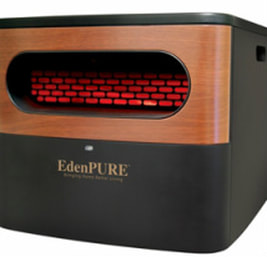
Thanks to EdenPURE, who really launched this category, there's a lot of hype these days about infrared heaters, and I thought I'd share a balanced perspective on this topic, giving you a sense of their value ... and where traditional heaters are just as good.
(Glad to find an honest review? Please share this article with others. Thanks!)
The commercials tell you that these heaters will save you money. The truth is (as of 2013 -- costs may change), electricity costs much LESS to produce heat than propane or oil. So if you're heating your home with either of those, you CAN save a lot by choosing an electric heater. Turn down your home heat (don't turn it off unless your home is very small) and use electric heaters to warm areas you use the most. Of course you may need an extra heater to help in a room that doesn't get much heat from the furnace, even in a house warmed by electricity or gas. (This keeps you from overheating the rest of the house to warm that room.)
In short, know that any electric heater (not just infrared) can help you save money if used correctly.
Also know the difference between radiant and convection heaters. Radiant heaters are very good at warming one spot, so if you're sitting still at a desk or standing at a workbench in the basement or garage, they can run on lower wattage and keep you warm. They just won't warm the entire room, basement, or garage.
Convection heaters push out warm air and, as it moves through the room, the room gets warm. Those without fans take longer to warm a room, but are quieter. Those with fans warm up a room more quickly. We'll talk here about convection heaters with fans, as the most popular infrared heaters are of this type.
(Glad to find an honest review? Please share this article with others. Thanks!)
The commercials tell you that these heaters will save you money. The truth is (as of 2013 -- costs may change), electricity costs much LESS to produce heat than propane or oil. So if you're heating your home with either of those, you CAN save a lot by choosing an electric heater. Turn down your home heat (don't turn it off unless your home is very small) and use electric heaters to warm areas you use the most. Of course you may need an extra heater to help in a room that doesn't get much heat from the furnace, even in a house warmed by electricity or gas. (This keeps you from overheating the rest of the house to warm that room.)
In short, know that any electric heater (not just infrared) can help you save money if used correctly.
Also know the difference between radiant and convection heaters. Radiant heaters are very good at warming one spot, so if you're sitting still at a desk or standing at a workbench in the basement or garage, they can run on lower wattage and keep you warm. They just won't warm the entire room, basement, or garage.
Convection heaters push out warm air and, as it moves through the room, the room gets warm. Those without fans take longer to warm a room, but are quieter. Those with fans warm up a room more quickly. We'll talk here about convection heaters with fans, as the most popular infrared heaters are of this type.
Are Infrared Heaters Worth More?
I believe this is the big question. Traditional electric heaters start at $20. You can get a good one with a thermostat, remote control, and other features for $50 to $80. Infrared heaters usually start around $200 (although some are closer to $100). Are they worth the extra money?
From my testing (with a thermometer and humidity gauge), it is NOT true that they heat a room more quickly or that they keep more moisture in the room or that they keep from "burning" the air ... when compared to traditional ceramic heaters. These comparisons are being made to RADIANT heaters and to those that rely on combustion like propane or oil heaters. For simple heating, you can stick with a normal ceramic heater.
But there are some ways in which infrared heaters may have benefits.
From my testing (with a thermometer and humidity gauge), it is NOT true that they heat a room more quickly or that they keep more moisture in the room or that they keep from "burning" the air ... when compared to traditional ceramic heaters. These comparisons are being made to RADIANT heaters and to those that rely on combustion like propane or oil heaters. For simple heating, you can stick with a normal ceramic heater.
But there are some ways in which infrared heaters may have benefits.
Benefits of Infrared Heaters
- Infrared rays have therapeutic benefits. There are arguments about whether near infrared or far infrared radiation offers more benefits. My opinion is that near infrared has at least some definite advantages, and on my wife's website, we explain how to build a low-cost near infrared sauna.
However, I believe there are still benefits to far infrared, as that found in infrared heaters. Certainly far infrared rays will penetrate your body more than just warm air, and many people feel it helps with joint pain and even other health issues. But let's be clear: in a RADIANT heater, those rays will hit you directly. In a CONVECTION heater (as those we're talking about), the infrared element is inside a metal box heating air that is pushed out. So is there any benefit?
I wouldn't normally expect infrared to pass through metal, but I've seen reviews by people who can literally tell the difference in joint pain when not using these heaters. So either they are reflecting up and out with the warm air, or they're getting out in another way. But in short, I think there may indeed by therapeutic benefits to these heaters. - The wide mouth design of EdenPURE models and those with a similar design are QUIETER than traditional heaters. Blow a similar amount of air through a large hole or small one, the small one is louder.
- This same design means producing a broader area of nice warm wind rather than a thin, hot stream. They may heat an area at about the same pace, but if the heater is facing you, you may prefer the wide mouth like I do. It warms your entire body. As someone who's usually cold in the winter, I can tell you that I prefer having an EdenPURE pointed at me than I do our other space heater. (But read on so you know what type to get if you plan to get one.) Again, any one with a wide mouth design should be fine, and other brands are usually less expensive.
PTC vs. Quartz Bulbs
When you're looking at infrared heaters, keep the bulbs in mind. Quartz bulbs have been used for several years. Lifetime on these is around 20,000 hours, which is a lot ... if they last that long. In many cases, heaters are designed in a way that the bulbs blow much sooner than that. On the other hand, PTC elements will probably far outlast your heater, as they have a lifetime of around 80,000 hours. They also offer a wider spectrum of infrared radiation, so may have more therapeutic effects.
Recommended Infrared Heaters
It used to be that the infrared heaters with the most important features cost several hundred dollars. But today you can usually get a good one for well under $200, and many close to $100. Click this link for those at 4+ star reviews; look for those with a wide mouth designed and PTC heating elements.
For its price point, you may want to choose this infrared heater -- it's a dual quartz and PTC heater, but is close to just $100 last I checked.
For its price point, you may want to choose this infrared heater -- it's a dual quartz and PTC heater, but is close to just $100 last I checked.
